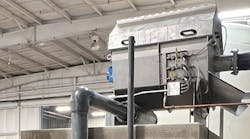Prior to fitting Retroflo's new pump control system, Northumbrian Water's Skinningrove Sewage Pumping Station was not economical or very efficient, despite relatively new pumps and VSDs. Frequent pump blockages meant numerous reactive maintenance call-outs to unblock the pumps. Retroflo's new approach has virtually eliminated blockages at the station and vastly reduced operational expenditure (OPEX).
Skinningrove Sewage Pumping Station is located on the North East coast and situated in an area of natural beauty frequented by dog-walkers and ramblers. As such it has been of concern to Northumbrian Water due to the risk of discharges as a result of pump blockages. The introduction of the Retroflo pump control system has not just maintained consents through reduction of blockages but also dramatically reduced energy costs for the station.
Retroflo's pump control system was specifically designed to control pumping stations holistically, rather than just the components within. Through continuous dynamic monitoring of the pump characteristics over a range of wet well levels and pump speeds, the system was able to utilize the full range of pumping data available at Skinningrove to optimize the performance of the station. It is also the first product on the market to offer Pre-Blockage Detection, Consent Security, Intelligent Flushing Cycles, Periodic Efficiency Testing, and Asset Data Storage, within a single system.
Blockages occur in the pumping of sewage due to the gradual build-up of debris on pump impellers. During this gradual build up the pumps operate inefficiently and this eventually leads to a blockage, resulting in time consuming and costly call-outs.
During the first 12 month period from installation of the Retroflo system at Skinningrove, in excess of 1000 successful Pre-Blockage Detection routines were implemented, all of which returned the pumps to optimum performance. This meant that no operator/maintenance intervention was required to remove blockages from the pumps. The pumps were also regularly inspected during this initial period and a massive improvement regarding the cleanliness of the impellor was observed.
As the site was already fitted with VSD drives, the principal reason for installing Retroflo's pump control system was blockage alleviation. However, by initiating pump reversal cycles on detection of partial blockages and returning the pump to optimum operating conditions, the improved pump performance equates to a 12% decrease in power during normal operation. At Skinningrove this has resulted in a savings of 0.45p every 12.2 seconds based on costs to pump m³. This energy saving coupled with the savings from no call-outs meant the capital expenditure of installing the system was repaid within the first 12 months.
A further benefit of introducing the pump control system was a vast improvement in the condition of the Wet Well due to the initiation of the Intelligent Flushing Cycle. Retroflo's Intelligent Flushing Cycle ensures that wells are kept cleaner therefore alleviating solids settlement and septicity problems, which in turn reduces the threat of blockages to the pumps and reduces the need for routine cleansing.
Scope of Work
The scope of modification work undertaken on the Skinningrove site was to retrofit the RPC_2000 controller to the existing infrastructure.
The patented system's Pre-Blockage detection provides dynamic monitoring of the pump operating characteristics. When a pump is monitored outside of its normal operating characteristics, indicative of a potential pump blockage event, corrective action is taken to remedy the problem i.e. reversal of the suspect pump.
If successful the blockage is removed and normal operation resumes. However, following a maximum of three unsuccessful reversal cycles the suspect pump is locked out. This saves operating costs by ensuring pumps are not operated inefficiently. Following pump lock-out, the standby pump assumes duty and is operated.
Should the duty pump trip, the locked-out pump is reset and is operated. This reset action ensures that the station will remain pumping, albeit inefficiently, allowing consents to be maintained. An alarm is forwarded to the Regional Telemetry system informing the operators that action is required. This may be used to indicate that pumps are operating inefficiently and operating costs are increased.
The installation of Retroflo's Intelligent Flushing Cycle enables selection by volume or time, which ensures adequate dilution of settled solids enabling the solids to be passed forward. It also allows rising main self-cleansing velocities to be achieved, at regular intervals, to prevent deposition in the main and fat build-up in the well. The cycle can be triggered at a period when electricity tariffs are low.
Work at the site also included the optimization of the existing control system following works flow instrument failure. The works flow meter is located at the Treatment Works, the flow signal being generated to the Transfer Station PLC via the communications network. Originally when the flow signal to the Transfer Station PLC was lost the pumps were inhibited to protect the works from unknown flow rates. Immediate manual operator intervention was required to prevent spill events. Under the current modified regime, upon flow meter failure the pumps remain operational. The duty pump responds to the normal duty pump start and duty pump stop level set-points and operates at a fixed speed. This speed is selected to best deliver the required consent flow rate without compromising the works. As with the Consent alarm, this new regime reduces reactive maintenance costs by reducing the potential for site visits.
Operating Philosophy
The station operates on a Duty/Standby basis. Whenever a pump is called to run, the pump boosts (50Hz) for 30 seconds in order to get velocities through the system.
The pump speed is then controlled to maintain a pre-determined level within the wet well; currently set at 1.60 meters. This method of control provides the best platform to achieve maximum efficiencies, as pumped flow theoretically matches influent flow.
When inflow increases, the level in the wet well also increases. As a result the pump speed is increased and delivered flow increases. Alternatively, when inflow decreases, the level in the wet well decreases, the pump speed is decreased and delivered flow decreases.
The speed of the duty pump is controlled to deliver a minimum of 60 L/s. During times when the influent flow drops below this 60 L/s set-point, the level in the wet well will eventually fall below the duty pump stop level. At this point the duty pump boosts at 100% speed for 10 seconds. This is to prevent both solids deposition in the line and rag balling in the riser pipe. Duty is then rotated.
During normal conditions, with the duty pump in operation and the monitored wet well below High Level, if the Retroflo Pre-Blockage Detection facility detects the pump operating outside of its normal operating characteristics remedial action is taken:
• The duty pump is stopped. The system does not perform a boost operation prior to stopping to prevent compounding the potential blockage event. At this point Pre-Blockage Detection monitoring is disabled.
• The duty pump is operated in reverse direction (at 60% speed) for 30 seconds in attempt to remove the blockage, after which, the duty pump is operated in the forwards direction at 100% speed reference for 30 seconds. Normal operation resumes and Pre-Blockage Detection is re-enabled.
• If the blockage is still evident, the reversing cycles continue for a maximum of three attempts, after which the suspect pump is tripped and locked-out by the Retroflo system. An alarm is forwarded to the Regional Telemetry system.
• The standby pump assumes duty and is operated as the duty pump. Should the control system detect this pump operating outside of its normal operating characteristics, a maximum of three pump reversal sequences are implemented, after which the pump continues to operate and an 'Efficiency Alarm' is forwarded to the regional telemetry system. This provides indication that despite there being no current threat to the Consent, the pump is operating at reduced efficiencies and operating costs are increased. This enables action to be taken to address the problem.
• If at any time a pump is locked-out by the system and the operating pump becomes failed due to other reasons, the locked-out pump is reset and operated by the system irrespective of efficiencies and costs to prevent compromising the Consent.
The speed of the duty pump is controlled to deliver a maximum of 82 liters per second. During times when the influent is greater than 82 L/s the level in the wet well will rise to the 'High Level' set-point. At this point a High Level alarm is forwarded to the Regional Telemetry system. Pre-blockage Detection is disabled and Consent Alarm monitoring is effective. The system continues to controls the pump to deliver 82 liters for the duration of the High Level event.
This is to ensure that greater emphasis is placed on the importance of processing flows during storm events rather than reduced efficiencies and increased operational costs due to partial blockages. It isn't desirable to perform repeated reversal sequences when in storm conditions, due to the increased risk of spillage.
Benefits of the System
A small blockage in the pump body presents a greater threat to further debris passing through the pump, which tends to collect and add to the original problem. Pre-modification this manifested until the pump could no longer deliver Consent flow or the pump protection caused the pump to trip i.e. Over-current or Over-temperature etc. This resulted in a breakdown situation requiring operation and maintenance personnel attending the site, removing the pump from its location and removing the blockage; a timely and costly procedure. Removing the smaller debris upon initial pick-up prevents the large build up which ultimately may lead to a breakdown situation. Each one of these blockages events, if not addressed could eventually over time lead to a breakdown situation requiring operator and maintenance intervention.
Over a 12 month period the control system has performed in excess of 1000 Pre-Blockage Detection pump reversal sequences. It would be incorrect to state that every one of these potential blockage events would have resulted in a breakdown situation requiring maintenance intervention, however each of the reversals allowed the pump to be returned back to its efficient state automatically, in capturing the blockage at this early stage blockages are eradicated which in turn means any Health and Safety issues associated with blockages are removed.
When in High Level conditions the pumps are controlled to maintain a forward flow to the works of 82 L/s. Under optimum operating conditions each pump is observed operating at approximately 96% speed reference to deliver 82 L/s (slight variations exist). Over time settlement is intensified and the pumps pick up debris.
Ordinarily, (when not in High Level conditions), Pre-blockage Detection would detect theses partial blockages and perform reversal cycles; however as previously described, provided Consent flows are being achieved, reversal cycles aren't implemented due to the increased risk of spillage.
Consequently this debris continues to impede the pumps performance and the control system increases the speed of the under-performing pump in an effort to deliver the required 82 L/s. The end result is a pump operating at 100% speed reference (as opposed to 96% speed reference) to deliver the equivalent (and maybe less) flow rate.
Theoretically, the decrease in power consumption from 100% pump speed to 96% pump speed may be calculated by applying the following recognized equation:
>> Click here for more detailed product/company information
April 2009
###



